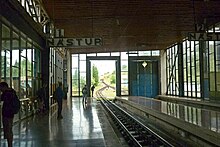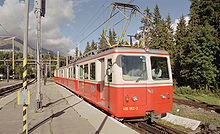Štrba – Štrbské Pleso rack railway
| Štrba – Štrbské Pleso | |||||||||||||||||||||||||||||||||||||||||||||||||||||||||||||||||||||
|---|---|---|---|---|---|---|---|---|---|---|---|---|---|---|---|---|---|---|---|---|---|---|---|---|---|---|---|---|---|---|---|---|---|---|---|---|---|---|---|---|---|---|---|---|---|---|---|---|---|---|---|---|---|---|---|---|---|---|---|---|---|---|---|---|---|---|---|---|---|
| Course book series (ZSSK) : | 182 | ||||||||||||||||||||||||||||||||||||||||||||||||||||||||||||||||||||
| Route length: | 4.75 km | ||||||||||||||||||||||||||||||||||||||||||||||||||||||||||||||||||||
| Gauge : | 1000 mm ( meter gauge ) | ||||||||||||||||||||||||||||||||||||||||||||||||||||||||||||||||||||
| Power system : | 1.5 kV = | ||||||||||||||||||||||||||||||||||||||||||||||||||||||||||||||||||||
| Maximum slope : | 150 ‰ | ||||||||||||||||||||||||||||||||||||||||||||||||||||||||||||||||||||
| Rack system : | Strub / von Roll | ||||||||||||||||||||||||||||||||||||||||||||||||||||||||||||||||||||
| Top speed: | 30 km / h | ||||||||||||||||||||||||||||||||||||||||||||||||||||||||||||||||||||
|
|||||||||||||||||||||||||||||||||||||||||||||||||||||||||||||||||||||
The Štrba-Štrbské Pleso rack railway ( Ozubnicová železnica Štrba-Štrbské Pleso in Slovak ) is a meter-gauge rack railway in the Slovak High Tatras . This tourist train starts at the Štrba (Eng. Tschirm, Hungarian Csorba ) train station on the former Kaschau-Oderberger Railway and leads to the spa town of Štrbské Pleso (Eng. Tschirmer See, Hungarian Csorbató ) on the lake of the same name. In Štrbské Pleso, the line ends in a shared station with the Tatra Electric Railway .
The old rack railway
history
With the commissioning of the Kaschau-Oderberg Railway (Slovak / Czech: Košicko-bohumínská dráha , Hungarian: Kassa-Oderbergi Vasút ) in 1871, the High Tatras also received their first railway connection. With the beginning of tourism, the first hotels were built on Štrbské pleso (German: Tschirmer See) and the place was named a spa. Hiking trails and mountain huts were also built later .
The Kaschau-Oderberger Bahn, under the direction of Emil Várnai, developed the project of a meter-gauge rack railway, which should connect Štrbské pleso to the Csorba station (today: Štrba ). On July 30, 1895, the railway was licensed by the Hungarian Ministry of Commerce. The construction was carried out very quickly, so that the line could already be opened on July 30, 1896. As an operating company, the Kaschau-Oderberger Bahn founded the Csorbatoi Fogaskerekü Vasut (Slovak: Ozubnicová železnica Štrbského plesa , German Csorba cog railway ). The route was only operated during the course season between June and September and during the ski season in winter. Traffic was idle for more than six months a year.
From the 1920s onwards, there was strong competition from motor vehicle traffic and the railways became unprofitable. In 1924, the line, together with the Kaschau-Oderberger Railway, became the property of the Czechoslovak State Railway ČSD. The Tatranská elektrická vicinálna dráha (TEVD) , founded in 1927, took over the operation of the Tatra Electric Railway , but refused to take over the uneconomical and outdated rack railway.
During the Great Depression , traffic on the rack railway was finally stopped on September 14, 1932. On December 11, 1936, the license to operate expired. The line was then dismantled in the 1940s.
vehicles
The Wiener Lokomotivfabrik Floridsdorf delivered two cogwheel steam locomotives in 1896 with the serial numbers 1012 and 1013, which were given the numbers 1 and 2 . The ČSD later classified the locomotives as U 29.001 and U 29.002. Locomotives of largely identical construction were also manufactured for the Achenseebahn in Austria , where they are still in use today.
Furthermore, there were four passenger cars and two freight cars, which were built by Ganz in Budapest .
Technical specifications
- Track width: 1000 mm
- Rack system: Riggenbach
- Route length: 4.75 km
- Length of the rack section: 4.05 km
- greatest gradient: 127 ‰
- Base station in Štrba at an altitude of approx. 896 m
- Difference in altitude: 444 m
The new rack railway
history
In 1968, in connection with the Nordic World Ski Championships in 1970 in Štrbské Pleso, plans began to rebuild the short Zubačka railway (after Ozubnicová železnica , "cog railway"). Two thirds of the old route could be used again for the new construction, the rest of the route was re-routed. In Štrbské Pleso, a new joint station with the Tatra Electric Railway was built. A track connection is used to transfer the vehicles of the rack railway. A new departure hall for the rack railway trains was built at the Štrba station, which in 2015 still exudes a dignified elegance after 45 years of use. The line was electrified with 1500 volts DC and thus with the same system as the Electric Tatra Railway. On February 12, 1970, operations on the new rack railway to Štrbské Pleso opened. The place is 1346 m above sea level.
Track equipment
All of the tracks used in regular operation are equipped with racks from the modified Strub system (now known as the von Roll system). The racks end bluntly in the Štrbské Pleso station before the junction with the mainline track towards Starý Smokovec, there are no special rack entrances. In both stations there are relay interlockings with light signals, the points are remote-controlled. The movable intermediate rails are moved along with the tongues by the drive via transmission rods. The switches and station tracks are automatically reported free by track circuits , the main track is provided with steel sleepers and is not isolated between the entry signals
The complete renovation of the track system began in July 2020. It should cost 18 million euros ; operations will be replaced by buses during construction until the end of May 2021.
vehicles
The three new rack rail multiple units were supplied by the Swiss Locomotive and Machine Factory SLM in Winterthur . The trains each consist of a control car of the R 29.0 series (today: BR 905.95), which is lined up uphill, and the EM 29.0 series railcar (today: BR 405.95). All platforms are on the left-hand side in the direction of Štrbské Pleso, so the cars only have three doors each on this side, through which a quick passenger change is possible. The railcars can run individually, for this there is a normally covered auxiliary control desk at the interchange. This option was used more often in the off-season in the first few years.
In October 2018, the ZSSK ordered five new electric rack and pinion trains from Stadler Rail / Switzerland. They will replace the now 50-year-old first generation vehicles by 2022 and correspond to the GTW type , as it is already used on the network of the neighboring Electric Tatrabahn as a pure adhesion vehicle . Part of the order is also a locomotive with a combined electric and diesel drive, which is particularly required for snow clearing operations.
literature
- Jaroslav Opava: The electric rack railway in the High Tatras . In: Wolfgang Messerschmidt (Ed.): Locomotive magazine . No. 59 . Franckh'sche Verlagshandlung, W. Keller & Co. , 1973, ISSN 0458-1822 , p. 155-157 .
- Arthur Meyer, Josef Pospichal: Rack railway locomotives from Floridsdorf . Verlag bahnmedien.at, Vienna 2012, ISBN 978-3-9503304-0-3
- Neue Zürcher Zeitung : A mountain railway for Czechoslovakia ; from May 11, 2015
Web links
Individual evidence
- ↑ 1003 Štrba - Štrbské Pleso. In: Atlas Drah. Retrieved July 13, 2020 (Czech).
- ↑ 1003a Historické miesto 1003/1 - Štrbské Pleso / pôvodná localita /. In: Atlas Drah. Retrieved July 13, 2020 (Czech).
- ↑ 682 Csorba-Csorbató. Retrieved July 13, 2020 (Hungarian).
- ↑ sram: Tatra cog railway is being modernized . In: Eisenbahn-Revue International , p. 372.
- ↑ "Stadler Doda jednotky a lokomotivu per zubačku na Štrbské Pleso" on zdopravy.cz




